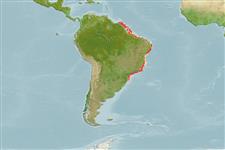Environment: milieu / climate zone / depth range / distribution range
Ökologie
seewasser; süßwasser; brackwasser demersal; tiefenbereich 1 - 16 m (Ref. 36453). Tropical; 7°N - 29°S, 55°W - 30°W
Western Atlantic: Suriname to Brazil.
Size / Gewicht / Alter
Maturity: Lm ? range ? - ? cm
Max length : 20.5 cm TL Männchen/unbestimmt; (Ref. 102462); common length : 12.0 cm TL Männchen/unbestimmt; (Ref. 5217); max. veröff. Gewicht: 177.96 g (Ref. 102462)
Kurzbeschreibung
Morphologie | Morphometrie
Rückenflossenstacheln (insgesamt): 0; Rückenflossenweichstrahlen (insgesamt): 55-60; Afterflossenstacheln 0; Afterflossenweichstrahlen: 40 - 44. Pectorals either vestigial or reduced to 1-2 rudimentary rays (Ref. 36453).
Found more abundantly on shallow soft bottoms of brackish estuaries or hypersaline lagoons. Enters freshwaters at least to an elevation of 10 m. Inhabits rivers and creeks and probably feeds on aquatic insects and crustaceans (Ref. 36880).
Life cycle and mating behavior
Geschlechtsreife | Fortpflanzung | Ablaichen | Eier | Fecundity | Larven
Cervigón, F., R. Cipriani, W. Fischer, L. Garibaldi, M. Hendrickx, A.J. Lemus, R. Márquez, J.M. Poutiers, G. Robaina and B. Rodriguez, 1992. Fichas FAO de identificación de especies para los fines de la pesca. Guía de campo de las especies comerciales marinas y de aquas salobres de la costa septentrional de Sur América. FAO, Rome. 513 p. Preparado con el financiamento de la Comisión de Comunidades Europeas y de NORAD. (Ref. 5217)
IUCN Rote Liste Status (Ref. 130435)
Bedrohung für Menschen
Harmless
Nutzung durch Menschen
Mehr Information
NamenSynonymeMetabolismusRäuberÖkotoxikologieFortpflanzungGeschlechtsreifeAblaichenSpawning aggregationFecundityEierEientwicklung
ReferenzenAquakulturAquakultur ProfilZuchtlinienGenetikElectrophoresesVererbbarkeitKrankheitenVerarbeitungNutrientsMass conversion
Tools
Zusatzinformationen
Download XML
Internet Quellen
Estimates based on models
Preferred temperature (Ref.
123201): 22.6 - 28.1, mean 27.5 °C (based on 223 cells).
Phylogenetic diversity index (Ref.
82804): PD
50 = 0.5010 [Uniqueness, from 0.5 = low to 2.0 = high].
Bayesian length-weight: a=0.01148 (0.00909 - 0.01450), b=3.13 (3.06 - 3.20), in cm total length, based on LWR estimates for this species (Ref.
93245).
Trophic level (Ref.
69278): 3.3 ±0.45 se; based on food items.
Widerstandsfähigkeit (Ref.
120179): hoch, Verdopplung der Population dauert weniger als 15 Monate. (Preliminary K or Fecundity.).
Fishing Vulnerability (Ref.
59153): Low vulnerability (11 of 100).
Nutrients (Ref.
124155): Calcium = 255 [117, 432] mg/100g; Iron = 1.15 [0.57, 2.18] mg/100g; Protein = 17.6 [16.3, 19.0] %; Omega3 = 0.133 [0.061, 0.267] g/100g; Selenium = 35 [17, 74] μg/100g; VitaminA = 19.4 [6.3, 58.6] μg/100g; Zinc = 1.52 [1.01, 2.20] mg/100g (wet weight);
